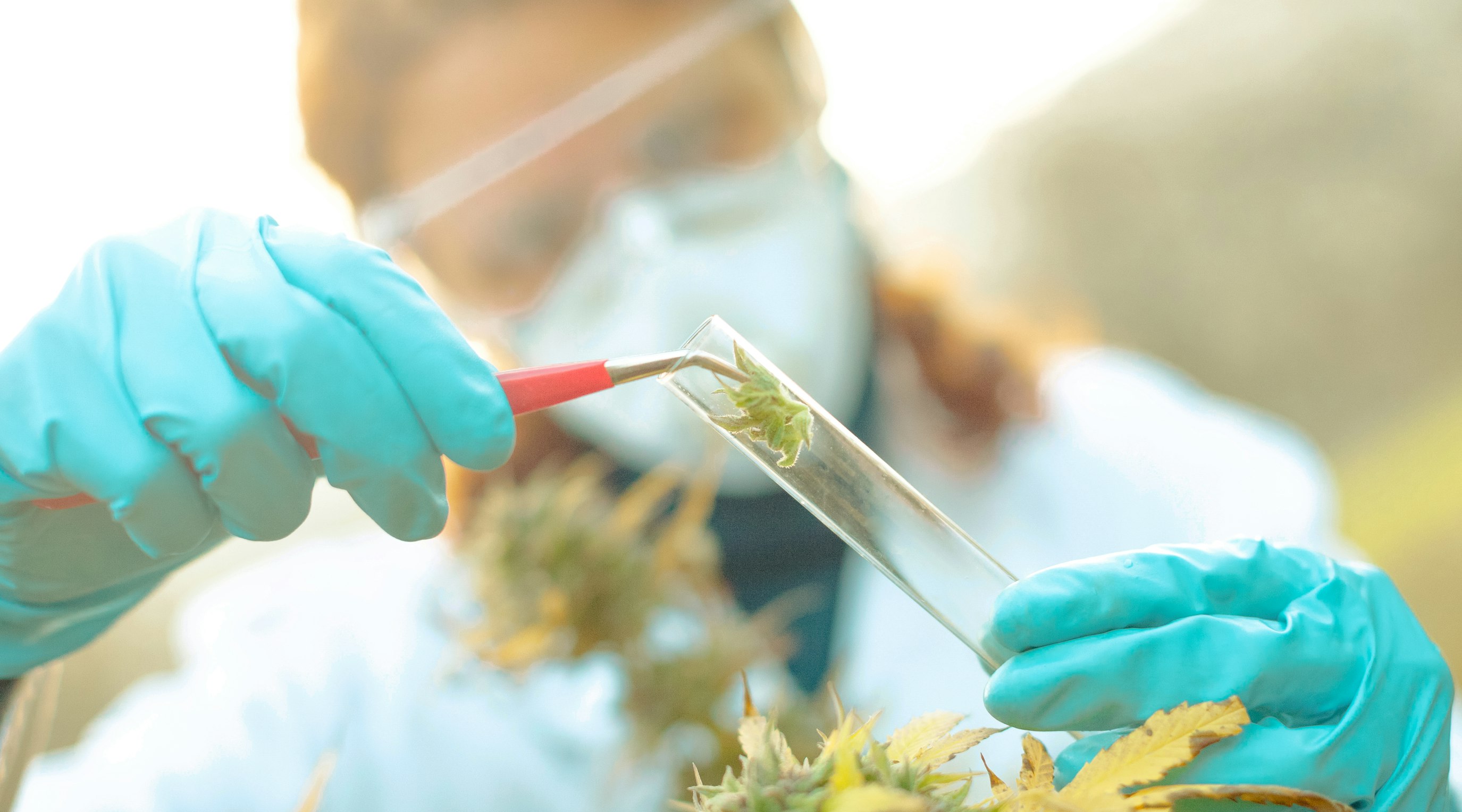A full guide to the endocannabinoid system
9 min read
Lucy MacKinnon
Contents
With the social and political acceptance and awareness of medical cannabis growing here in the UK, the need for both patients and the wider public to have a better understanding of how cannabis (and its contained active ingredients) interacts with the body is more pressing than ever before.
Although the endocannabinoid system wasn’t discovered until the late 1980s, it is actually the largest receptor system and regulator of homeostasis (the body's internal balance) in humans, and so it is surprising it remained undetected for so long. This system plays a crucial role in various physiological and psychological processes, including appetite, pain sensation, mood regulation, and memory. It is also responsible for the therapeutic effects of medical cannabis.
We’ve created this article to answer the question ‘What is the endocannabinoid system’ clearly and concisely, establishing its role within the body, its functions, and its interaction with cannabis compounds.
What is the endocannabinoid system?
Deep within our bodies, there is a remarkably intricate regulatory system called the endocannabinoid system (ECS) that is still somewhat overlooked in the wider medical field, despite its crucial role in our wellbeing. This complex network is made up of receptors, enzymes, and naturally produced cannabinoids called endocannabinoids.
Think of the ECS as a finely tuned orchestra, with all its components working harmoniously to maintain balance and homeostasis.
Endocannabinoids
Endocannabinoids act as the orchestra's conductor, notifying the body to start a specific process using cell signalling. They are naturally produced by our bodies and act as messengers to reinstate balance. There are two different types of endocannabinoids created in our bodies, named anandamide and 2-arachidnoylglycerol, that naturally act as neurotransmitters behind the scenes in our brain and body.
Receptors
The musicians and their instruments in this metaphor are represented as receptors. Just like in an orchestra, receptors listen to messages given by endocannabinoids and respond accordingly, in this case by initiating a biological response. There are two primary receptors in the ECS, CB1 receptors, which are mainly found in the brain and central nervous system, and CB2 receptors, which can be primarily located in the immune system and peripheral tissues.
Enzymes
Lastly, enzymes play an important role in the ECS orchestra, acting the same way silence does in music by either maintaining rhythm, or bringing the song (or process) to a close. Enzymes like Fatty Acid Amide Hydrolase (FAAH) and monoacylglycerol Lipase (MAGL) are responsible for breaking down endocannabinoids once their tasks have been accomplished, ensuring signals don’t linger in the body after being fulfilled.
In essence, the endocannabinoid system is an intricate network of internal communication that ensures harmony within the body. Just like a composer conducting a symphony, the ECS orchestrates and controls a vast range of components simultaneously, creating a delicate balance within the body.
Functions of the endocannabinoid system
Now that you know a bit more about the anatomy of the endocannabinoid system and how it is structured, we’ll delve into the top five functions it regulates to ensure equilibrium.
Mood Regulation
One of the ECS’ most important roles is its regulation of mood, where it seeks to stabilise feelings. When emotions run high, endocannabinoids like anandamide step in to calm mental turbulence.
Pain Perception
Much like with feelings of anxiety or depression, when the body senses pain, the ECS kicks into action. When pain or discomfort is experienced, our bodies naturally release endocannabinoids to dampen the sensation and diminish pain signal perception.
Sleeping Patterns
Ensuring we get a sound night's sleep is another job done by our ECS. Here endocannabinoids help regulate our circadian rhythms to try to help us fall asleep, and wake up, at the right times. By interacting with receptors involved in the sleep-wake cycle, the ECS assists in maintaining healthy sleeping patterns.
Appetite Control
Our endocannabinoid systems also play a pivotal role in our appetites, regulating the feeling of hunger, so our bodies know when they need sustenance, and when to refrain. Hunger signals are triggered by CB1 receptors when it is time to refuel, which in turn induces the individual’s appetite.
Immune function
As well as having influence on our emotions and sensations, the ECS also plays a role in immune function. CB2 receptors, which are primarily found in immune cells, help to regulate a number of these responses such as inflammation. When the body encounters a threat, endocannabinoids can modulate these responses to ensure they’re not excessive.
Cannabinoids and the endocannabinoid system
Endocannabinoids are the signalling molecules at the heart of the ECS, but they are also part of a larger class of natural compounds named cannabinoids. Much like how our bodies naturally produce endocannabinoids, plants naturally produce another type of cannabinoid called phytocannabinoids. These can also be mimicked, recreated, or adapted in the lab, giving a third type of cannabinoids called synthetic cannabinoids.
Cannabis contains two well-known phytocannabinoids:
- Cannabidiol, more commonly known as CBD – a non-intoxicating compound with a range of potential therapeutic effects such as anti-inflammatory, analgesia, and mood-stabilizing properties.
- Tetrahydrocannabinol, or THC – the psychoactive compound responsible for the "high" associated with recreational cannabis use. Along with its intoxicating properties, THC has been shown to have potential medicinal benefits such as pain relief and appetite stimulation.
These cannabinoids have a unique relationship with the ECS, and they are able to navigate their own way around this internal network, often by posing, or disguising themselves as, endocannabinoids. And so, when cannabis is consumed, the endocannabinoid system is given another role as an endogenous cannabinoid system – regulating cannabis compounds like THC and CBD.
Tetrahydrocannabinol has a remarkable resemblance to the endocannabinoid anandamide, making it easy for THC to influence the functions anandamide is typically responsible for regulating. This structural similarity allows THC to bind to CB1 receptors directly in the brain and central nervous system, where it can then influence a range of functions, such as inducing euphoria, altering perception, or stimulating appetite.
In contrast to THC, CBD does not have the same binding ability to CB1 as THC, but it has been shown to interact with the CB2 receptors weakly. It also influences the ECS by affecting the enzymes involved, reducing their ability to break down natural endocannabinoids like anandamide. This can lead to increased levels of anandamide, which is known to ease anxiety and stabilise mood.
In its whole plant form, where both THC and CBD concentrations are present, cannabis has been attributed with an astonishing range of therapeutic benefits because of its chemical ability to essentially hijack, or overthrow, the ECS’ vast network of natural regulatory processes. Because the ECS connects so many components of the body together, cannabis is able to explore most of these avenues, sensing where the body's imbalances are so that it can signal responses to rectify the issue.
Cannabis has been shown to have positive influences on inflammation, seizures, and pain in clinical trials around the world, and there are a number of experts also investigating its potential as an antioxidant, anxiolytic, antiemetic, and anti-depressant.
The anti-spasticity, anti-tumour, and anti-seizure properties within cannabis are also of great interest to those exploring its therapeutic potential, and so far the results have offered significant hope to some of those grappling with debilitating physiological, psychological, or physical conditions.
Conclusion
As we navigate the complex terrain that is the endocannabinoid system, its essential role in our health and homeostasis becomes ever more apparent. But you may be wondering, what happens when this orchestra falls out of tune?
Some patients may suffer from endocannabinoid deficiencies, which can be caused by several factors including genetics, lifestyle choices, and stress levels. When the ECS is not functioning properly, it can lead to a whole host of issues, ranging from mood imbalances to chronic pain or disturbed sleep patterns.
Which is where cannabis can come in handy. Acting as a natural ally, cannabis cannabinoids engage with the ECS in an attempt to restore balance and recalibrate the body's internal systems. By integrating with the ECS’s intricate network, it addresses imbalances from inflammation to seizures, pain and beyond.
If you’re struggling with one of the processes or functions regulated by your endocannabinoid system, medical cannabis may be a therapeutic option worth exploring. Just like with any form of treatment, getting specific and individualised advice from your doctor or healthcare provider is the best place to start.
Releaf understands that embarking on your medical cannabis journey can be a little overwhelming, and even slightly intimidating – that’s why we offer tailored monthly packages, specialist consultations for medical cannabis, and our unique medical cannabis card to give you the peace of mind that your treatment is protected, all based on your medical cannabis prescription.
Share article
Did you like this article?
It is important to seek medical advice before starting any new treatments. The patient advisors at Releaf are available to provide expert advice and support. Alternatively, click here to book a consultation with one of our specialist doctors.
Elevate your wellness with medical cannabis
Get comprehensive care, convenience, and confidence with an all-in-one treatment plan.
Am I eligible?Authors
With five years of journalism and healthcare content creation under her belt, Lucy strives to improve medical cannabis awareness and access in the UK by producing high quality, credible content.
Editorial Policy
All of our articles are written by medical cannabis experts, guided by strict sourcing guidelines, and reference peer-reviewed studies and credible academic research. Our expert clinical team and compliance specialists provide valuable insights to ensure accuracy when required. Learn more in our editorial policy.
Need more help?










